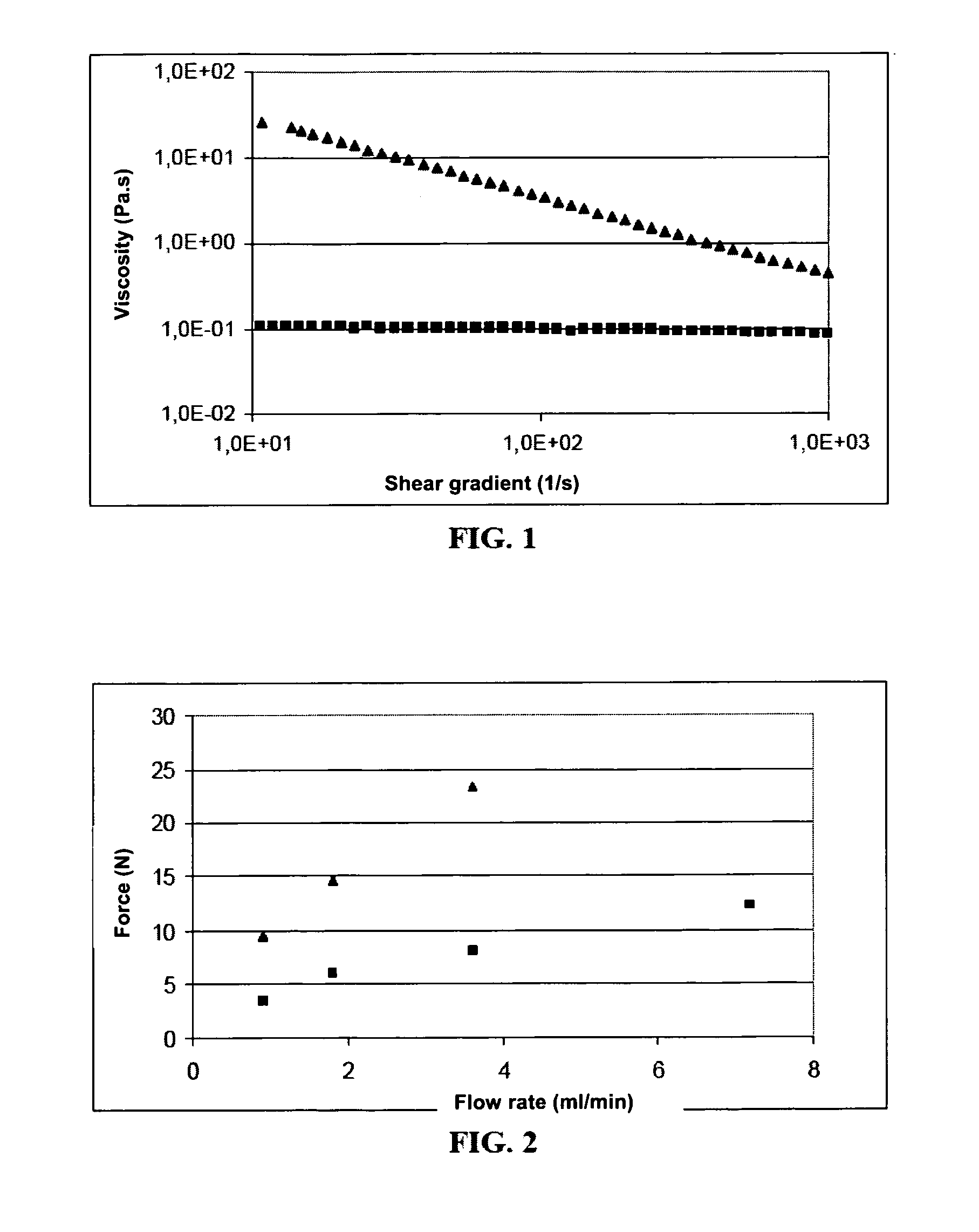Dispersion of polyamino acids in a continuous lipid phase
a technology of polyamino acids and lipids, applied in the direction of biocide, plant growth regulators, pharmaceutical non-active ingredients, etc., can solve the problems of poor therapeutic cover, serious long-term side effects, and the inability of the system to be injected, so as to increase the release time of a therapeutic protein associated, increase the viscosity of the therapeutic form, and reduce the stability of the protein
- Summary
- Abstract
- Description
- Claims
- Application Information
AI Technical Summary
Benefits of technology
Problems solved by technology
Method used
Image
Examples
example 1
Preparation of the Suspension
[0147]An amphiphilic polyamino acid is prepared as follows: The alpha-L-polyglutamate polymer, having a molecular weight equivalent to about 10,000, relative to a polyoxyethylene standard, is obtained by the polymerization of NCAGluOMe, followed by hydrolysis, as described in patent application FR 2 801 226. 5.5 g of this alpha-L-polyglutamate polymer are solubilized in 92 ml of dimethylformamide (DMF) by heating at 40° C. for 2 hours. Once the polymer has been solubilized, the temperature is allowed to fall to 25° C. and 1.49 g of D-alpha-tocopherol of natural origin (98.5%, obtained from ADM France), previously solubilized in 6 ml of DMF, 0.09 g of 4-dimethylaminopyridine, previously solubilized in 6 ml of DMF, and 0.57 g of diisopropylcarbodiimide, previously solubilized in 6 ml of DMF, are added in succession. After stirring for 8 hours at 25° C., the reaction medium is poured into 800 ml of water containing 15% of sodium chloride and hydrochloric ac...
example 2
Stability of the Active Principle Improved by the Presence of the Polyamino Acid
[0150]A suspension is prepared according to the protocol described in Example 1, a protein, namely interferon alpha-2b (IFNα2b), being incorporated into the aqueous phase at a concentration of 1 mg / g.
[0151]The IFNα2b in the suspension is quantified by a sandwich ELISA (IM3193 kit, Beckman Coulter). After the suspension containing the IFNα2b and the amphiphilic polyamino acid has been kept for one week at 37° C., the ELISA, after extraction, gives an 85% recovery of the IFNα2b, compared with the same emulsion kept for one week at 5° C. Under the same storage conditions, but in the absence of amphiphilic polyamino acid, the recovery is only 6%.
example 3
Variation in Viscosity / Injectability
[0152]An aqueous phase of amphiphilic polyamino acid at a concentration of 50 mg / ml (which is a physical gel at this concentration) is dispersed in the lipid phase according to the procedure described in Example 1 to give a suspension of hydrogel. The viscosity value was measured by comparison for the suspension and the initial gel. This measurement is made by characterizing the change in viscosity as a function of shear gradient (from 10 to 1000 s−1) at 25° C. using a stress-controlled rheometer (Gemini, Bohlin) with cone-and-plate geometry installed (2 cm or 4 cm and 1° angle). The comparison shows that, at low shear gradients (10 s−1), the suspension is characterized by a viscosity in the order of 0.1 Pa·s, which is about 250 times lower than the viscosity of the initial gel (cf. FIG. 1).
[0153]The injectable character of this suspension was evaluated by the injectability test IT. This test consists in measuring the force that has to be applied ...
PUM
| Property | Measurement | Unit |
|---|---|---|
| Temperature | aaaaa | aaaaa |
| Percent by mass | aaaaa | aaaaa |
| Mass | aaaaa | aaaaa |
Abstract
Description
Claims
Application Information
 Login to View More
Login to View More - R&D
- Intellectual Property
- Life Sciences
- Materials
- Tech Scout
- Unparalleled Data Quality
- Higher Quality Content
- 60% Fewer Hallucinations
Browse by: Latest US Patents, China's latest patents, Technical Efficacy Thesaurus, Application Domain, Technology Topic, Popular Technical Reports.
© 2025 PatSnap. All rights reserved.Legal|Privacy policy|Modern Slavery Act Transparency Statement|Sitemap|About US| Contact US: help@patsnap.com



